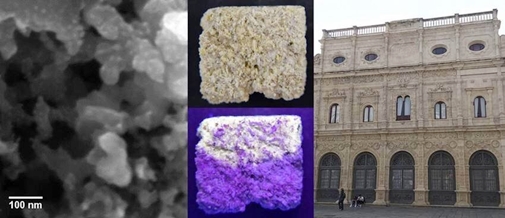|
NOVIDADES
The fluorescence emitted by zinc oxide quantum dots can be used to determine the penetration depth of certain substances used in the restoration of historical buildings. Researchers from Pablo de Olavide University (Spain) have tested this with samples collected from historical quarries in Cadiz, where the stone was used to build the city hall and cathedral of Seville. One of the main problems in the preservation of historic buildings is the loss of cohesion of their building materials. Restorers use consolidating substances to make them more resistant, such as lime (calcium hydroxide), which has long been used because of its great durability and high compatibility with the carbonate stone substrate.  Calcium hydroxide nanoparticles doped with zinc oxide quantum dots (tiny white spheres). By treating the limestone samples with this material, the ultraviolet radiation can detect the penetration of the treatment (yellowish) into the stone. On the right, the Seville City Hall. Credit: José María Martín/Javier Becerra
"The tiny quantum dots, which are smaller than 10 nanometers, are made of zinc oxide and are semiconductors, which gives them very interesting properties (different from those of larger particles due to quantum mechanics), such as fluorescence, which is the one we use," explains Javier Becerra, one of the authors. "Thanks to the fluorescence of these quantum dots, we can evaluate the suitability of the treatment for a monument," he adds. "We only need to illuminate with ultraviolet light a cross-section of the treated material to determine how far the consolidating matter has penetrated." In addition, the product, which the authors have named Nanorepair UV, acts as a consolidant due to the presence of the lime nanoparticles. Consolidation is a procedure that increases the degree of cohesion of a material, reinforcing and hardening the parts that have suffered some deterioration, which is frequent in historical buildings. The researchers have successfully applied their technique to samples collected in the historic quarries of El Puerto de Santa María and Espera (Cadiz), from where the stone used to build such iconic monuments as Seville Cathedral, a World Heritage Site since 1987, or the town's city hall, was extracted. "In the laboratory, we thus obtain an approximation of how the treatment will behave when it is actually applied to the monuments," says Becerra, who together with the rest of the team, is currently also testing mortars from the Italica and Medina Azahara archaeological sites. Plataforma SINC. Posted: May 08, 2020.
|
|||||||||||||||||||||||||